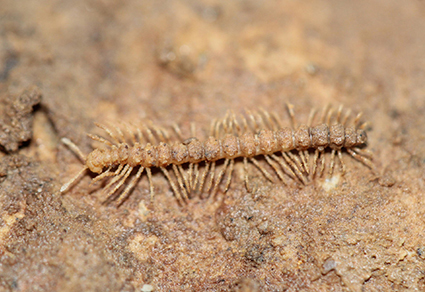Abstract
Pandirodesmus zogbiae sp. nov. is described as the first strictly troglobitic species of the genus and it represents the first record of both the genus and the tribe in Brazil. Specimens were collected from Paraíso Cave, the largest known limestone cave in the Amazon, located in Pará State. The species is distinguished by a unique combination of morphological characters, including slight heteropody, the presence of claws on all legs, concave microsculptures on the posterior rings, and a unique gonopodal conformation. In addition to a detailed morphological description, a key to species of the genus and a distribution map are provided.
References
- Adis, J. & Golovatch, S.I. (2000) Notes on the unique structure of the spiracles and legs in Pandirodesmus disparipes Silvestri, 1932 (Diplopoda, Polydesmida, Chelodesmidae) with possible implications concerning its mode of life. Fragmenta Faunistica, 43 (9), 97–108. https://doi.org/10.3161/00159301FF2000.43.9.097
- Antić, D. & Akkari, N. (2023) The genus Inversotyphlus Strasser, 1962, stat. nov. and Inversotyphlus ammirandus sp. nov., a new bizarre, highly modified troglobiotic millipede (Diplopoda, Julida, Julidae) from Albania, Balkan Peninsula. ZooKeys, 1184, 65–80. https://doi.org/10.3897/zookeys.1184.113498
- Attems, C. (1938) Myriapoda 3. Polydesmoidea II. Fam. Leptodesmidae, Platyrhachidae, Oxydesmidae, Gomphodesmidae. Das Tierreich, 69, 1–487. https://doi.org/10.1515/9783111430645
- Attems, C. (1940) Myriapoda 3, Polydesmoidea III. Fam. Polydesmidae, Vanhoeffeniidae, Cryptodesmidae, Oniscodesmidae, Sphaerotrichopidae, Peridontodesmidae, Rhachidesmidae, Macellolophidae, Pandirodesmidae. Das Tierreich, 70, 1–576 + i–xxxii. https://doi.org/10.1515/9783111609645
- Bouzan, R.S., Means, J.C., Ivanov, K., Ferreira, R.L., Brescovit, A.D. & Iniesta, L.F.M. (2022) Worldwide distribution of cavedwelling Chelodesmidae (Diplopoda, Polydesmida). International Journal of Speleology, 51, 235–248. https://doi.org/10.5038/1827-806X.51.3.2448
- Bouzan, R.S., Means, J.C., Ivanov, K., Ferreira, R.L., Brescovit, A.D. & Iniesta, L.F.M. (2024) Cayenniola albaserrata n. sp., a geographical relict from a Brazilian hotspot of subterranean biodiversity and the first troglobitic Priodesmini (Polydesmida: Chelodesmidae: Chelodesminae). Zootaxa, 5428 (4), 571–588. https://doi.org/10.11646/zootaxa.5428.4.6
- Brölemann, H.W. (1916) Essai de classification des Polydesmiens. Annales de la Société Entomologique de France, 84, 523–608. https://doi.org/10.1080/21686351.1915.12279415
- Centore, P. (2016) sRGB Centroids for the ISCC-NBS Colour System. Self Published, s.l., 21 pp. Available from: https://www.munsellcolourscienceforpainters.com/ColourSciencePapers/sRGBCentroidsForTheISCCNBSColourSystem.pdf (accessed 24 May 2025)
- Cook, O.F. (1895) Introductory note on the families of Diplopoda. In: Cook, O.F. & Collins, G.N. (Eds.), The Craspedosomatidae of North America. Annals of the New York Academy of Sciences, 9, pp. 1–9. https://doi.org/10.1111/j.1749-6632.1896.tb55430.x
- Cook, O.F. (1896) A new diplopod fauna in Liberia. American Naturalist, 30, 413–420. https://doi.org/10.1086/276402
- Enghoff, H., Golovatch, S., Short, M., Stoev, P. & Wesener, T. (2015) Diplopoda – taxonomic overview. In: Minelli, A. (Ed.), Treatise on Zoology – Anatomy, Taxonomy, Biology. The Myriapoda. Vol. 2. Brill, Leiden and Boston, pp. 363–454.
- Galo, J.B., Cardoso, G.M. & Ferreira, R.L. (2025) In the depths of the Amazon rainforest: a new troglobitic species of Circoniscus (Isopoda: Scleropactidae) from Brazil. Nauplius, 33, e20250545. https://doi.org/10.1590/2358-2936e20250545
- Golovatch, S.I. & Bouzan, R.S. (2025) Review of the South American millipede genus Camptomorpha Sivestri, 1897, with the description of a new species from Peru (Diplopoda: Polydesmida: Chelodesmidae). Arthropoda Selecta, 34 (1), 1–15. https://doi.org/10.15298/arthsel.34.1.01
- Hoffman, R.L. (1975) Chelodesmid studies VI. A synopsis of the tribe Trachelodesmini (Diplopoda: Polydesmida). Studies on Neotropical Fauna, 10 (2), 127–144. https://doi.org/10.1080/01650527509360488
- Hoffman, R.L. (1977) Chelodesmid studies. X. A synopsis of the tribe Priodesmini (Diplopoda: Polydesmida). Revue suisse de Zoologie, 84 (2), 349–359. https://doi.org/10.5962/bhl.part.91394
- Hoffman, R.L. (1980) Classification of the Diplopoda. Muséum d’histoire naturelle, Genève, 237 pp.
- Hoffman, R.L. (1982) Chelodesmid studies. XVIII. On some new or poorly-known taxa in the tribe Batodesmini (Polydesmida: Chelodesmidae). Journal of Natural History, 16, 633–654. https://doi.org/10.1080/00222938200770481
- Leach, W.E. (1815) A tabular view of the external characters of four classes of animals, which Linné arranged under Insecta; with the distribution of the genera composing three of these classes into orders, &c. and descriptions of several new genera. Transactions of the Linnean Society of London, 11, 306–400. https://doi.org/10.1111/j.1096-3642.1813.tb00065.x
- Means, J.C., Bouzan, R.S., Iniesta, L.F.M., Martínez-Torres, D., Vasquez-Valverde, L.F., Brescovit, A.D. & Ivanov, K. (2023) A review of the previously monotypic tribe Dibolostethini (Chelodesmidae: Chelodesminae) with description of two new species and a summary of the Chelodesmidae of the Tropical Andes Biodiversity Hotspot. European Journal of Taxonomy, 885, 65–85. https://doi.org/10.5852/ejt.2023.885.2189
- Pena-Barbosa, J.P.P., Sierwald, P. & Brescovit, A.D. (2013) On the largest chelodesmid millipedes: taxonomic review and cladistic analysis of the genus Odontopeltis Pocock, 1894 (Diplopoda; Polydesmida; Chelodesmidae). Zoological Journal of the Linnean Society, 169, 737–764. https://doi.org/10.1111/zoj.12086
- Pocock, R.I. (1887) On the classification of the Diplopoda. Annals and Magazine of Natural History, Series 5, 20 (118), 283–295. https://doi.org/10.1080/00222938709460057
- Shelley, R.M. & Smith, J.M. (2015) The enigmatic milliped genus Pandirodesmus Silvestri 1932 and description of a new species from Tobago represented by males (Polydesmida: Leptodesmidea: Chelodesmidae: Chelodesminae: Pandirodesmini). Insecta Mundi, 0444, 1–15.
- Silvestri, F. (1932) A new and extraordinary genus of the diplopod family, Polydesmidae, from British Guiana. American Museum Novitates, 564, 1–12.
- VandenSpiegel, D., Golovatch, S.I. & Rutherford, M.G. (2022) The millipede genus Pandirodesmus Silvestri, 1932 in Trinidad and Tobago, Caribbean, with the description of P. jaggernauthi sp. nov. from Trinidad (Diplopoda, Polydesmida, Chelodesmidae, Pandirodesmini). Zootaxa, 5104 (4), 567–576. https://doi.org/10.11646/zootaxa.5104.4.6
- Wang, X., Edwards, R.L., Auler, A.S., Cheng, H., Kong, X., Wang, Y., Cruz, F.W., Dorale, J.A. & Chiang, H.W. (2017) Hydroclimate changes across the Amazon lowlands over the past 45,000 years. Nature, 541 (7636), 204–207. https://doi.org/10.1038/nature20787
- Wynne, J.J., Howarth, F.G., Sommer, S. & Dickson, B.G. (2019) Fifty years of cave arthropod sampling: techniques and best practices. International Journal of Speleology, 48 (1), 33–48. https://doi.org/10.5038/1827-806X.48.1.2231


